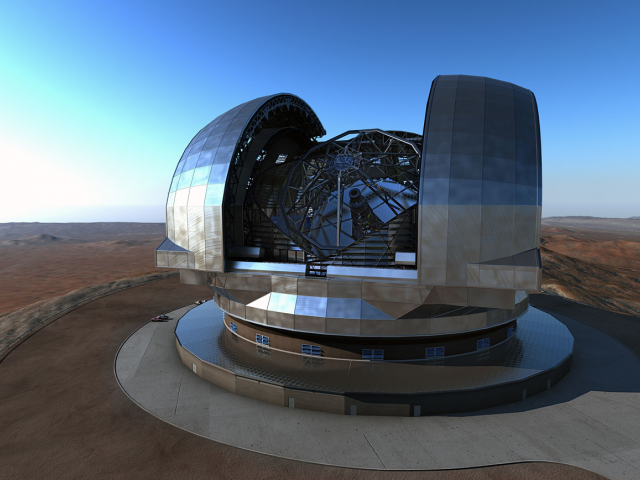
Top 5 locations for stargazing
Astrotourism is becoming more popular every year. People are willing to travel thousands of kilometers to admire the stars. But which places on Earth are considered the best for this? Let's find out now!




ELT (South America)
The leader of this ranking is the Extremely Large Telescope (ELT), a super large optical infrared telescope. It is located in the Atacama Desert in northern Chile, South America. This telescope is part of the European Southern Observatory (ESO). The distinguishing feature of ELT is adaptive optics technology, which has made it recognized as the best telescope in the world. The use of this innovation allows astronomers to observe celestial bodies with extreme clarity. This unique device actively corrects atmospheric defects. ELT uses deformable mirrors and complex algorithms designed for instant correction of atmospheric turbulence. As a result, the images obtained are much sharper than the data collected by telescopes of previous generations. In addition, ELT is equipped with a variety of advanced elements. Each of them is intended to achieve a specific research goal. Thanks to ELT, scientists can study various cosmic phenomena, penetrate distant galaxies, and monitor the appearance and development of stars. The ELT telescope covers a wide range of wavelengths, from visible to mid. Specialists consider it an exceptionally important innovative solution due to its complex adaptive optics system and advanced technologies.

FAST (China)
The FAST telescope is the second most powerful telescope in the world, which replaced the Arecibo Observatory as the world's largest single-dish radio telescope. It is located in the Guizhou province of China. Thanks to its truly fantastic size and advanced technologies, this spherical telescope with a 500-meter aperture is used to study distant galaxies. The telescope is the pride of China's space industry. The key task of this device is radioastronomical study of the Universe. FAST is designed to detect and study radio waves generated by celestial bodies such as pulsars and various galaxies. This design allows astronomers to study cosmic phenomena and investigate the structure and development of galaxies using powerful radio emission. The FAST telescope is characterized not only by its enormous size but also by its revolutionary dynamic surface system. It includes hundreds of panels, each with its control. These panels can change in real-time and are designed to account for thermal and gravitational effects during the study of cosmic phenomena.

GTC (Spain)
Experts consider the Gran Telescopio Canarias (GTC) telescope the third most powerful instrument for studying celestial bodies and phenomena. It is located at the Roque de los Muchachos Observatory on the Spanish island of Las Palmas. According to scientists, the GTC has become a kind of home for this multifunctional astronomical observatory. It is among the most powerful telescopes in the world, belonging to the Institute of Astrophysics of the Canary Islands. Among the features of GTC is high image clarity. The main task of GTC is to conduct innovative astronomical research. This instrument is involved in several space sectors. The Gran Telescopio Canarias is equipped with modern equipment designed to study unusual cosmological phenomena, including the nature of dark matter and the features of distant galaxies. Additionally, GTC is used to observe exoplanets and star populations. This facility attracts attention not only for its gigantic size but also for its advanced technologies and adaptability. It employs revolutionary adaptive optics technology designed to account for atmospheric aberrations.

SKA (Australia, South Africa, United Kingdom)
Another large-scale multinational research construction is the SKA telescope. It consists of almost 131,000 antennas (over 500 arrays of 256 antennas), each resembling a two-meter wire Christmas tree. This telescope is capable of detecting radiation at frequencies from 50 to 350 MHz. According to scientists, SKA opens a new era in radio astronomy and offers innovative tools for studying space. This device is created to study radio waves generated by celestial bodies to explore a range of astrophysical processes. Additionally, scientists will be able to use SKA to map hydrogen on distant planets, study black holes, delve into the secrets of pulsars, and explore the origin and evolution of galaxies. This telescope is characterized by enormous size and power. It is designed to collect data on a large scale. Advanced technologies are used here, which are best suited for analyzing vast amounts of data. The telescope generates an unprecedented rate of information transmission. To support its operation, advanced supercomputer technologies are required for processing and obtaining scientific information.

ALMA (South America)
Closing the top five most powerful telescopes in the world is the innovative astronomical observatory ALMA. It is located in the Atacama Desert in Chile (South America). According to scientists' estimates, ALMA has a unique characteristic – the ability to capture millimeter and submillimeter wavelengths. This is one of the most powerful radio telescopes in the world. International organizations, including those from Europe, North America, and East Asia, work in this observatory. Using ALMA, astronomers can study remote galaxies, analyze astrophysical phenomena, and explore space. This telescope is distinguished by an innovative interferometric array design. Additionally, ALMA consists of 66 high-precision antennas arranged in an array that work collectively. They form a single sensitive beam of antennas capable of perceiving any signals. The antennas in the instrument can be tuned to various wavelengths, from the smallest to the elongated ones. This helps astronomers record even the smallest details of space and conduct comprehensive monitoring of the sky.

Astrotourism is becoming more popular every year. People are willing to travel thousands of kilometers to admire the stars. But which places on Earth are considered the best for this? Let's find out now!